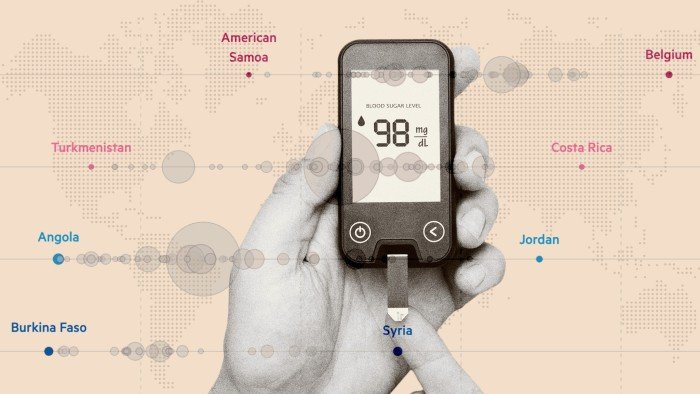Diabetics left without treatment as global rate of disease doubles
Unlock the Editor’s Digest for free
Roula Khalaf, Editor of the FT, selects her favourite stories in this weekly newsletter.
Global diabetes rates have doubled over the past 30 years, with many middle- and low-income countries failing to provide sufferers with sufficient access to treatment, according to an international study.
The report published in The Lancet on Wednesday evening found that rates of diabetes in adults rose from 7 per cent to 14 per cent between 1990 and 2022 across 200 countries and territories.
The review of health data from 141mn people over three decades showed that the highest levels of diabetes per capita — more than 25 per cent — were found in the Pacific islands, Caribbean, Middle East, north Africa, Pakistan and Malaysia.
Overall, India accounts for more than a quarter of the world’s 828mn diabetes sufferers, while China has 148mn and the US has 42mn.
Diabetes is a serious chronic condition characterised by high levels of the sugar glucose in the bloodstream. Its spread is a sign of how people are living longer on average but in some ways have a lower quality of life because of the increase in conditions associated with poor diet, pollution or other social and environmental factors.
The study also found that nearly 60 per cent of diabetics over 30 years old — totalling almost 450mn people — did not receive medication in 2022 despite the availability of off-patent pharmaceuticals.
Insufficient access to drugs to treat the condition was most prominent in Africa and Asia.
“This is especially concerning as people with diabetes tend to be younger in low-income countries,” said Majid Ezzati, the report’s senior author and a professor of global environmental health at Imperial College London.
“In the absence of effective treatment, they are at risk of life-long complications — including amputation, heart disease, kidney damage or vision loss — or in some cases premature death,” he added.
The caseload rise for the predominant type 2 diabetes, caused by the body’s ineffective use of the glucose-regulating hormone insulin, is closely linked to the global surge in obesity. Biological changes triggered by excess body fat are a leading risk factor for developing diabetes.
Bianca Hemmingsen, technical lead for the World Health Organization’s diabetes programme, said problems included failures to diagnose the condition and lack of access to drugs even when less expensive non-branded medicines were available.
“Supply chain issues and the dominance of a few pharmaceutical companies keep prices of some products high and unaffordable for many,” she said. “Even when generic alternatives exist, financial barriers, lack of inclusion of diabetes in universal healthcare packages and high out-of-pocket costs further exacerbate the treatment barriers.”
Insulin production is dominated by the US’s Eli Lilly and Europe’s Sanofi and Novo Nordisk. All three pharmaceutical companies have established access schemes to provide insulin at lower cost to diabetics in poorer countries through initiatives such as working with manufacturers in Egypt and South Africa to localise production.
But these efforts are an inadequate “patchwork of strategies” that leave many lower income countries with poor access to vital drugs, according to the Access to Medicines Foundation, a non-governmental group.
“You hope that partnerships broaden access in all of Africa but if they are limited in scope and scale, it’s not necessarily going to meet the needs,” said Jayasree Iyer, the foundation’s chief executive. “The paper outlines the needs are not only there, but growing over time.”
New drugs for diabetes known as GLP-1s, such as Novo Nordisk’s Ozempic, remain unavailable to diabetics in low and middle income countries, Iyer added. GLP-1s are expensive and are in demand in richer countries, where they are often used as obesity treatments.
But even wealthy countries faced pressures keeping up with the “relentless condition”, said Helen Kirrane, head of policy and campaigns at charity Diabetes UK.
“This research shows we’re facing a global diabetes crisis,” she said. “It should be a major concern to policymakers in the UK, where diagnoses of diabetes have doubled to 4.4mn in less than two decades.”
, #Diabetics #left #treatment #global #rate #disease #doubles





